States of matter solid - Study guides, Class notes & Summaries
Looking for the best study guides, study notes and summaries about States of matter solid? On this page you'll find 1988 study documents about States of matter solid.
Page 4 out of 1.988 results
Sort by

-
Elementary OSAT Subtest 2 Questions and Answers Graded A+
- Exam (elaborations) • 21 pages • 2024
-
Available in package deal
-
- $9.99
- + learn more
Elementary OSAT Subtest 2 Questions and Answers Graded A+ What is the function of the digestive system in the human body? The function of the digestive system is to break down food, absorb nutrients, and eliminate waste. How does water cycle through the environment? Water cycles through the environment via processes like evaporation, condensation, precipitation, and runoff. What are the three states of matter? The three states of matter are solid, liquid, and gas. What i...
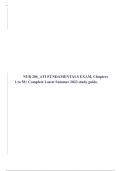
-
NUR 206_ATI FUNDAMENTALS EXAM, Chapters 1 to 58 | Complete Latest Summer 2023 study guide.
- Other • 53 pages • 2023
- Available in package deal
-
- $9.00
- 3x sold
- + learn more
5/3/19 ATI FUNDAMENTALS EXAM 1. CHAPTER 1: HEALTH CARE DELIVERY SYSTEMS A. Components of Health care systems a. Participants 1. Consumers- clients 2. Providers a. Licensed providers: registered nurses, license practical (or vocational) nurses (LPN), advanced practice nurses (APN), medical doctors, pharmacists, dentists, dietitians, physical/respiratory/occupational therapists, etc b. Unlicensed providers: assistive personal b. Settings 1. Hospitals, homes, skilled nursing, assisted living, schoo...

-
Test Bank For Foundations of College Chemistry 14th Edition Hein
- Exam (elaborations) • 660 pages • 2023
-
- $30.37
- 1x sold
- + learn more
Package Title: Hein Test Bank Course Title: Hein 14e Chapter Number: 3 Question type: Multiple Choice 1) All matter is composed of elements. Approximately how many elements are there? a) 4 b) 10 c) 68 d) 100 Answer: D Difficulty: easy Learning Objective 1: Define an element and write the chemical symbol for an element when given its name. Section Reference 1: Section 3.1 2) The smallest particle of an element that can exist is called a(n) ___. a) atom b) ferrul...
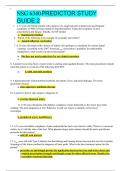
-
NSG 6340 PREDICTOR STUDY GUIDE 2
- Exam (elaborations) • 26 pages • 2024
-
- $13.09
- 2x sold
- + learn more
NSG 6340 PREDICTOR STUDY GUIDE 2 1. A 37-year-old female patient with a history of a single episode of depression and frequent complaints of PMS is being treated for hypothyroidism. Today she complains of poor concentration and fatigue. Initially, the NP should: a. Question her further 3. Which of the following is an example of secondary prevention? a. Annual influenza vaccination 7. A 35-year old female with a history of mitral valve prolapse is scheduled for routine dental cleaning. Accor...
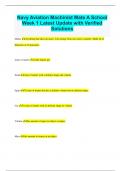
-
Navy Aviation Machinist Mate A School Week 1 Latest Update with Verified Solutions
- Exam (elaborations) • 18 pages • 2024
-
- $9.99
- + learn more
Navy Aviation Machinist Mate A School Week 1 Latest Update with Verified Solutions Matter Anything that takes up space. Can change from one state to another. Made up of Elements or Compounds. states of matter solid, liquid, gas Solid state of matter with a definite shape and volume liquid A state of matter that has a definite volume but no definite shape. Gas A state of matter with no definite shape or volume Volume the amount of space an object occupies Mass the amount...
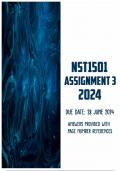
-
NST1501 Assignment 3 2024 | Due 28 June 2024
- Exam (elaborations) • 10 pages • 2024
-
- $2.86
- + learn more
QUESTION 1 1.1 Define the following terms: 1.1.1 Solvent 1.1.2 Matter (4) 1.2 Give an example of a heterogenous mixture. (2) 1.3 Identify 2 different ways of separating homogenous mixtures (4) 1.4 State the three different states of matter. (3) 1.5 Identify the process: 1.5.1 Change of state from liquid to solid 1.5.2 Change of state from gas to liquid 1.5.3 Change of state from solid to gas 1.5.4 Change of state from liquid to gas 1.5.5 Change of state from gas to solid 1....

-
TEAS 7 Chemistr1 Question and answers rated A+
- Exam (elaborations) • 19 pages • 2024
-
Available in package deal
-
- $14.49
- + learn more
TEAS 7 Chemistr1 Question and answers rated A+Kinetic Molecular Theory Theory that all matter is composed of particles (atoms and molecules) moving constantly in random directions. Molecule motion changes as is heat added or removed. What does the phase of a substance depend on? 1. Temperature 2. Pressure Mass Amount of matter in an object, the number of molecules Volume Amount of space occupied by a specific number of molecules 3 states of matter 1. Solid 2....
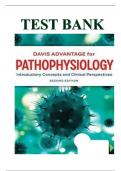
-
Pathophysiology Introductory Concepts and Clinical Perspectives 2nd Edition Capriotti Test Bank
- Exam (elaborations) • 831 pages • 2024
-
- $24.39
- 1x sold
- + learn more
1. Which statement regarding the sodium-potassium pump is correct? 1. The cell’s plasma membrane is more soluble to sodium ions than potassium ions. 2. The concentration of sodium ions should be higher inside the cell compartment. 3. The concentration of potassium ions should be higher outside the cell compartment. 4. The active transport involves pumping out three sodium ions and pumping in two potassium ions. 2. What is the process in which glucose is used to create energy? 1. Autol...
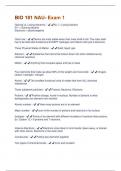
-
BIO 181 NAU- Exam 1 (Questions & Answers) Rated 100% Correct!!
- Exam (elaborations) • 10 pages • 2024
- Available in package deal
-
- $7.99
- + learn more
Gaining vs. Losing electrons - ️️N+1 = Losing electron N-1 = Gaining electron Electrons = electronegative Octet rule - ️️Atoms are most stable when their outer shell is full. The outer shell has to be filled with 8 electrons EXCEPT Hydrogen and Helium with just 2 electrons. Three Physical States of Matter - ️️Solid, liquid, gas Element - ️️Substance that cannot be broken down into other substances by chemical reactions Matter - ️️Anything that occupies space and has a...
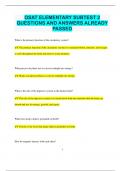
-
OSAT ELEMENTARY SUBTEST 2 QUESTIONS AND ANSWERS ALREADY PASSED
- Exam (elaborations) • 11 pages • 2024
-
Available in package deal
-
- $9.99
- + learn more
OSAT ELEMENTARY SUBTEST 2 QUESTIONS AND ANSWERS ALREADY PASSED What is the primary function of the circulatory system? The primary function of the circulatory system is to transport blood, nutrients, and oxygen to cells throughout the body and remove waste products. What process do plants use to convert sunlight into energy? Plants use photosynthesis to convert sunlight into energy. What is the role of the digestive system in the human body? The role of the digestive system i...

That summary you just bought made someone very happy. Also get paid weekly? Sell your study resources on Stuvia! Discover all about earning on Stuvia


